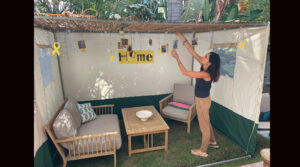By Deborah Danan

Yael Aisenthal-Kordevani decorated her sukkah in the city of Modi’in with symbols of the year since Hamas’ Oct. 7 attack on Israel, Oct. 15, 2024. (Courtesy Aisenthal-Kordevani)
(JTA) — TEL AVIV — When she was preparing her Passover seder in April, Shlomit Sattler set a symbolic seat place for Hersh Goldberg-Polin, who lived in her Jerusalem neighborhood before he was taken hostage by Hamas.
Now, as she prepares for Sukkot less than two months after Goldberg-Polin was killed in captivity, Sattler is once again focusing holiday preparations on the hostages held in Gaza. Though there won’t be a seat for Goldberg-Polin or anyone else, she’s hanging pictures of the 101 remaining hostages on the walls of her sukkah.
She also added a banner featuring an iconic picture of Goldberg-Polin distributed by his family’s congregation, Hakhel, which called the item, designed by the famed Israeli caricaturist Michel Kichka, “a chain of light, love and peace” in his honor.
“This time it’s too late for him — we won’t be able to save him, but we can raise awareness about the others,” Sattler said. “We need to remember at every moment that there are 101 people that we can do something for.”
Like Sattler, Israelis across the country are taking the upcoming festival of Sukkot as an opportunity to draw attention to the hostages that Hamas has held captive in Gaza for more than a year. To many Israelis, the traditional themes of Sukkot — gathering, vulnerability and dependence on God’s protection — lend themselves to placing the hostages’ plight front and center.
And the core ritual of Sukkot — building a makeshift hut, decorating it with all manner of symbolism and living in it for a week — likewise brings to mind other Israelis whose lives have been upended in the past year, such as soldiers fighting on Israel’s multiple fronts, or the tens of thousands of civilians who fled their homes amid rocket fire last fall and have yet to return.
Because the Hamas attack took place on Simchat Torah, which falls immediately after Sukkot, sukkahs were still standing in the communities attacked on Oct. 7 and in many cases remained up almost all year, as the kibbutzes morphed into museums of the macabre and tour sites for Israelis and visitors seeking to understand the devastation firsthand.
“Seeing everyone set up their sukkahs in Jerusalem today, but all I can think of is … the sukkahs in the south that are still standing from last year,” Michal Sklar, a digital creator and immigrant from the United States, posted on social media, along with a picture of a sukkah in Netiv Haasara that she took in January.
In his Jerusalem sukkah, Rabbi Kenneth Brander, president of Ohr Torah Stone, a network of Orthodox schools and institutions, hung 32 mosaics depicting the symbols of the 32 Gaza border communities that were attacked on Oct. 7. The mosaics, also displayed in Hostages Square in Tel Aviv, were created by the network’s high school students as part of an art therapy project. Sixteen alumni of the schools, in addition to 36 relatives of students and faculty, have been killed in the conflict.
Brander also referenced the tradition of inviting real or symbolic guests — known as ushpizin — to one’s sukkah, which resonates with Israelis in a year of dislocation.
“As I look at these 32 mosaics, I welcome those forced to leave their homes who have been living in temporary homes for over a year now to come into our sukkah,” Brander said. “We ask God to shelter the evacuees, our soldiers and their families, and all of the hostages who are our missing ushpizin.”
For some residents of the ravaged Gaza border communities, constructing a sukkah this year is especially meaningful. Rather than signifying impermanence, this year the act of building a new sukkah is connoting presence and renewal.
At the kibbutz of Alumim, for example, 22 Thai and Nepalese agricultural workers, along with several members of security teams who had come to assist residents, were killed on Oct. 7. In the months following, the community sukkah was repurposed as a temporary military base and served as a mess hall for soldiers.
When residents began to return to the kibbutz in August, 10 months after the attack, they found the sukkah still standing. It was originally built to be used for just seven days.
For Alumim resident Racheli Yablonski, dismantling the old sukkah and rebuilding a new one marked an inflection point, solidifying her community’s commitment to reclaiming their home despite the trauma. On Oct. 7, her parents and husband had been in a building near the communal sukkah, witnessing a battle between the terrorists and the kibbutz’s rapid response team.
“Coming back was not easy at all, and each of us is dealing with things in our own way. But building the sukkah gave us a sense of strength, like we’re saying, ‘this is our home, our sukkah,’” she said. “The sukkah, which is a temporary structure, symbolizes the end of wandering — we no longer want to move or evacuate, we want to be here for good.”
Meanwhile, soldiers deployed to Gaza erected the first sukkah in the enclave in nearly 20 years, since Israel withdrew its settlers and soldiers from the territory in 2005. A viral photo circulated on Israeli news sites showed Israeli soldiers in the middle of the Gaza Strip next to a large sukkah. And as part of the war effort, the Israeli military Rabbinate has given soldiers pop-up sukkahs that accord with the dictates of Jewish law, which specify some construction details and also obligate Jews in most cases to eat inside a sukkah daily, without compromising safety.
Elsewhere, the connection between the sukkah and Oct. 7 is less immediate, but still poignant. Some are setting up extra chairs for the hostages or hanging posters of those missing or killed. Many are incorporating yellow, a color that has come to represent advocacy for the hostages.
Liat Collins said that while she didn’t have space for extra chairs in her small Jerusalem sukkah, she would instead be tying yellow ribbons to the ones already there. Naomi Rosen shared that she hadn’t planned on making any changes to her sukkah, but came home to find that her children — led by her 10-year-old — had created a paper chain using black and yellow ribbon symbols. In the northern Israeli community of Sde Yaakov, the Ben Shimon family also opted for a yellow theme, with yellow napkins and table runner, to honor the hostages.
“We are celebrating the holiday, but our hearts are still captive in Gaza,” said Orit Kehaty, who runs a kindergarten in Tel Aviv whose sukkah will display a sign with the message, “We are awaiting the return of the hostages.” It will also feature a yellow ribbon representing the captives’ plight.
Some Israelis said they were ambivalent about focusing Sukkot on the hostages because of how child-centric the holiday tends to be in Israel. Children decorate the sukkah, and with schools closed, the holiday is a popular time for family excursions around the country.
“You can’t just cancel Sukkot,” said LeAnn Langer. “But it’s a balance between remembering and thinking about the hostages while trying to shield our children as much as we can.” She plans on decorating her sukkah nonetheless with yellow ribbons, and a printout of all the hostages’ faces to hang on the wall.
Natali Torbati Gamliel said she felt conflicted about placing reminders of the hostages in her sukkah in Netanya.
“It feels like it’s forced,” she said. “We’re already remembering them every day without needing to make grand gestures.”
But she said the crisis had influenced her holiday plans even so. She is making an effort to host more guests this year, even people she doesn’t know. “In the past, I found it difficult to host everyone,” Gamliel said. “But this year, I want an open space, to create that sense of unity.”
Roxanne Fogelman Weinberger planned to reflect the impact of the war in her sukkah by hanging photos of the volunteering activities she and her children had done over the past year, including delivering baked goods each week to the evacuated residents of Kibbutz Nir Oz on the Gaza border, supporting war widows and writing cards and grilling food for soldiers.
“I want to remind our children that even though it’s been a hard year, we’ve done so much during this time of hardship and war to help others and come together as a nation, and also as a family, to help others that needed it,” she said.
For Aliza Petrack, a resident of Jaffa, building a sukkah isn’t in the cards this year, following a terror attack in the city that killed eight people earlier this month. She didn’t feel safe setting one up outside her building as she had done in previous years, she said, because two years ago, Arab children in her neighborhood threw a water bottle at her sukkah. “It wasn’t a big deal but definitely made us feel exposed,” she said.
Yael Aisenthal-Kordevani, who ran a successful graffiti tour company before the war broke out, has turned photographs of wartime graffiti posters from the streets of Tel Aviv into sukkah decorations. She is hanging them from a yellow ribbon in her sukkah in the central city of Modi’in.
After seeing a post from someone saying they didn’t know how to decorate their sukkah this year —an activity they usually described as a happy one done with children — Aisenthal-Kordevani decided to upload the photos, which include images of her own graffiti, for the public to download. One piece, created by Aisenthal-Kordevani herself, depicts Banksy’s famous “Girl with Balloon,” but instead of releasing a red balloon, a yellow one drifts away.
“Walking around Tel Aviv you see so much depressing graffiti about people’s feelings of despair and distress — which is a part of graffiti and I get it, but also we have to continue,” she said. “So I took pictures of the graffiti that I thought is more positive and can bring a bit of hope.”



